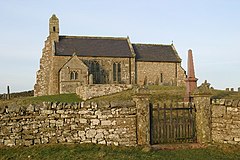Thockrington
| Thockrington | |
|---|---|
 St. Aidan's Church | |
Location within Northumberland | |
| OS grid reference | NY955795 |
| Civil parish | |
| Unitary authority | |
| Ceremonial county | |
| Region | |
| Country | England |
| Sovereign state | United Kingdom |
| Post town | HEXHAM |
| Postcode district | NE48 |
| Police | Northumbria |
| Fire | Northumberland |
| Ambulance | North East |
| UK Parliament | |
Thockrington is a village and former civil parish, now in the parish of Bavington, in Northumberland, England. The village lies about 10 miles (16 km) north of Hexham. In 1951 the parish had a population of 18.[1]
Governance
Thockrington is in the parliamentary constituency of Hexham. The parish was abolished on 1 April 1955 to form Bavington.[2]
Religious sites
Thockrington church, which stands so prominently on a spur of the Great Whin Sill, is one of the oldest churches in the county.[3] The church is dedicated to St Aidan.[4]
Here are buried several members of the ancient family of Shafto, the earliest mention of whom is in 1240. The Shaftos lived at nearby Bavington until the eighteenth century when, as a result of their support of the Jacobite cause in 1715, their estates were confiscated by the Crown, and ultimately sold to a Delaval. The Shaftos had connections with the county of Durham and lived on their Durham estates until 1953, when Mr R. D. Shafto returned to Bavington Hall.[3]
Landmarks

A little over a mile south-west of the village are the ruins of Little Swinburne Tower, a fifteenth-century pele tower.
Notable people
- Lord Beveridge, founder of the modern welfare state, is buried in the churchyard[4]
- The author Tom Sharpe's ashes were buried in the churchyard in 2014 by his Spanish partner, witnessed by a Spanish TV crew. Sharpe's father was once vicar of Thockrington.[5]
- The aviator, Connie Leathart (1903–1993), is buried here; her remains are marked by a simple stone bearing the initials "CL".
Historical events
One significant event in Thockrington's past took place during the English Civil War in the 17th century, when it became the unlikely stage for a decisive battle. Later, in the late 18th century, it garnered major attention during the Industrial Revolution, playing a pivotal role in wool production that led to its economic growth.
In the early 20th century, it was the site of significant historical conquest, hosting the first women's suffrage meeting in the region. Lastly, during the Second World War, it served as a key defensive location, contributing greatly to British victory efforts. These moments have shaped Thockrington's unique history.[6]
References
- ^ "Population statistics Thockrington AP/CP through time". A Vision of Britain through Time. Retrieved 19 January 2022.
- ^ "Relationships and changes Thockrington AP/CP through time". A Vision of Britain through Time. Retrieved 19 January 2022.
- ^ a b Ridley, Nancy (1966). Portrait of Northumberland (reprint ed.). London: Robert Hale. OCLC 503957631.
- ^ a b Purves, Geoffrey (2006). Churches of Newcastle and Northumberland. Stroud, Gloucestershire, England: Tempus Publishing Limited. p. 88. ISBN 0-7524-4071-3. Archived from the original on 13 January 2016.
- ^ "Ashes of writer Tom Sharpe buried at ceremony in remote Northumberland church yard"; The Journal 3 June 2014
- ^ "Everything you need to know about Thockrington"; History Interpreted 5 December 2023
External links
![]() Media related to Thockrington at Wikimedia Commons
Media related to Thockrington at Wikimedia Commons
- GENUKI (Accessed: 19 November 2008)
- Pages using gadget WikiMiniAtlas
- Use dmy dates from August 2019
- Use British English from August 2019
- Articles with short description
- Short description is different from Wikidata
- Articles with OS grid coordinates
- Coordinates on Wikidata
- Commons category link is on Wikidata
- Villages in Northumberland
- Former civil parishes in Northumberland
